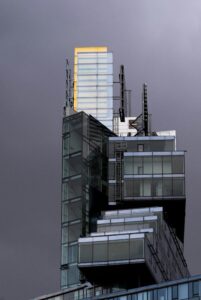Futuristic Architecture: Unveiling Bold and Imaginative Design Concepts


The world of architecture is evolving at a remarkable pace, pushing the boundaries of creativity and technology. Futuristic architecture embodies visionary design concepts that challenge traditional norms and reflect the needs of a rapidly changing society. This article explores the key elements, inspirations, and emerging trends that define the landscape of futuristic architecture.
Defining Futuristic Architecture
Futuristic architecture refers to innovative design that incorporates advanced materials, cutting-edge technology, and sustainable practices. It reflects a forward-thinking approach, prioritizing functionality, aesthetics, and environmental consciousness. Unlike conventional structures, futuristic buildings often feature unconventional shapes, vibrant colors, and dynamic forms that capture the imagination.
One of the hallmarks of futuristic architecture is its integration with technology. Architects are increasingly utilizing intelligent technologies to enhance the functionality of buildings. From energy-efficient systems to automation and artificial intelligence, these advancements create a seamless living experience where structures adapt to their occupants’ needs.
The Role of Sustainability
As the global population continues to rise and climate change becomes an urgent issue, sustainable design is at the forefront of futuristic architecture. Architects are prioritizing eco-friendly materials and energy-efficient solutions, striving to minimize their buildings’ environmental impact. This focus on sustainability includes harnessing renewable energy sources, such as solar and wind power, and implementing green roofs and vertical gardens to promote biodiversity.
Futuristic designs also emphasize the importance of resilience in the face of climate-related challenges. Structures are increasingly being designed to withstand extreme weather events, utilizing materials and techniques that enhance durability. For instance, buildings in flood-prone areas may be elevated or constructed with water-resistant materials to ensure safety and longevity.
Biomimicry: Nature as Inspiration
Biomimicry is an influential concept in futuristic architecture, drawing inspiration from nature’s designs and processes. Architects study natural systems to create innovative solutions that address human challenges. For example, the Eastgate Centre in Zimbabwe, designed by architect Mick Pearce, is modeled after termite mounds. This design allows the building to maintain a comfortable temperature without relying heavily on mechanical air conditioning.
Another notable example is the Eden Project in Cornwall, England, where geodesic domes mimic the structure of carbon molecules found in nature. This design not only provides a visually striking element but also creates a microclimate that supports diverse plant life.
By looking to nature for guidance, architects can create buildings that are not only aesthetically pleasing but also functionally superior, reflecting the interconnectedness of the built environment and the natural world.
The Guggenheim Museum, Bilbao
Designed by Frank Gehry, the Guggenheim Museum in Bilbao, Spain, is a prime example of deconstructive is architecture. Its fluid, organic forms, and titanium cladding create a striking visual impact, revolutionizing the perception of museum spaces. The museum has become a cultural landmark, attracting millions of visitors each year and transforming the surrounding urban landscape.
The Bosco Verticale, Milan
The Bosco Verticale (Vertical Forest) in Milan, designed by Stefano Boeri, features two residential towers adorned with over 9,000 trees and 20,000 plants. This innovative project promotes biodiversity and enhances air quality while providing residents with a unique living experience surrounded by nature. The integration of greenery into high-rise buildings reflects a growing trend toward biophilic design in urban environments.
The Impact of Virtual Reality and Augmented Reality
Advancements in virtual reality (VR) and augmented reality (AR) are revolutionizing the architectural design process. Architects can now create immersive environments that allow clients to experience designs before they are built. This technology enhances collaboration and communication, enabling architects to refine their concepts based on client feedback.
Additionally, VR and AR can facilitate community engagement in the design process. By creating virtual representations of proposed projects, architects can gather input from residents and stakeholders, ensuring that new developments align with the community’s needs and values.
The Future of Urban Living
As cities continue to grow, the need for innovative urban solutions becomes increasingly critical. Futuristic architecture aims to create intelligent cities that integrate technology, sustainability, and livability. This vision includes mixed-use developments that combine residential, commercial, and recreational spaces, fostering vibrant communities.
One emerging trend is the concept of 15-minute cities, where residents can access essential services, workplaces, and recreational areas within a short walk or bike ride. This approach prioritizes pedestrian-friendly design and reduces reliance on automobiles, promoting a healthier lifestyle and reducing carbon emissions.
Challenges and Considerations
While the prospects of futuristic architecture are exciting, several challenges must be addressed. The rapid pace of technological advancement can lead to design obsolescence, requiring architects to consider long-term sustainability and adaptability. Additionally, the integration of technology raises concerns about privacy and data security in smart buildings.
Futuristic architecture is a testament to human creativity and innovation, reflecting the ever-changing landscape of our world. By embracing sustainability, drawing inspiration from nature, and leveraging advanced technologies, architects are shaping a future that prioritizes functionality, aesthetics, and environmental stewardship. As we continue to explore bold and imaginative design concepts, the possibilities for creating spaces that enhance our lives and communities are limitless. Through collaboration and a commitment to sustainability, the architectural visions of tomorrow can become a reality today, transforming our cities and enriching our experiences.
